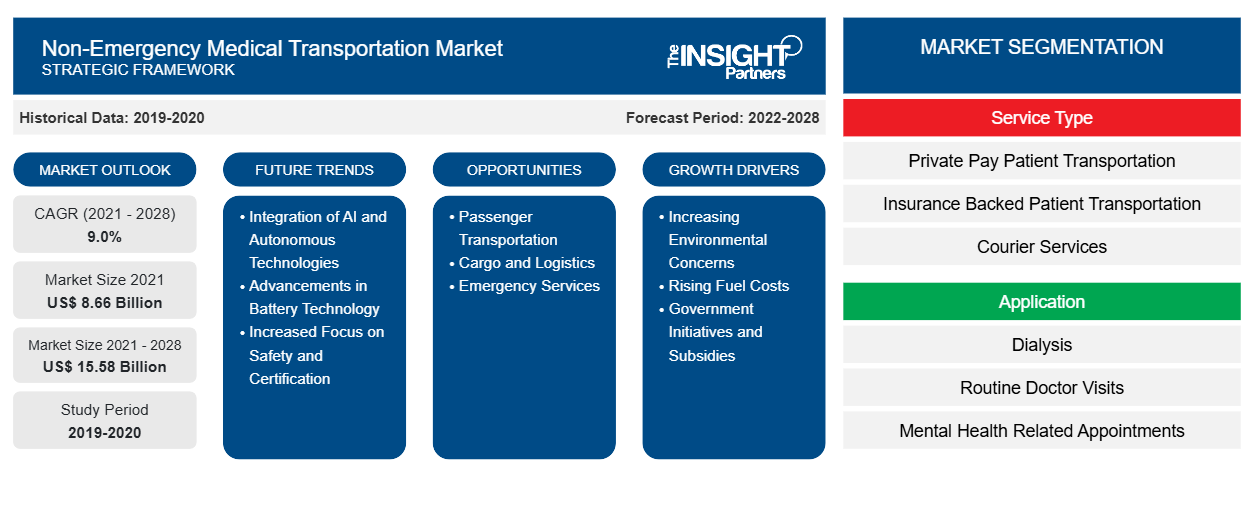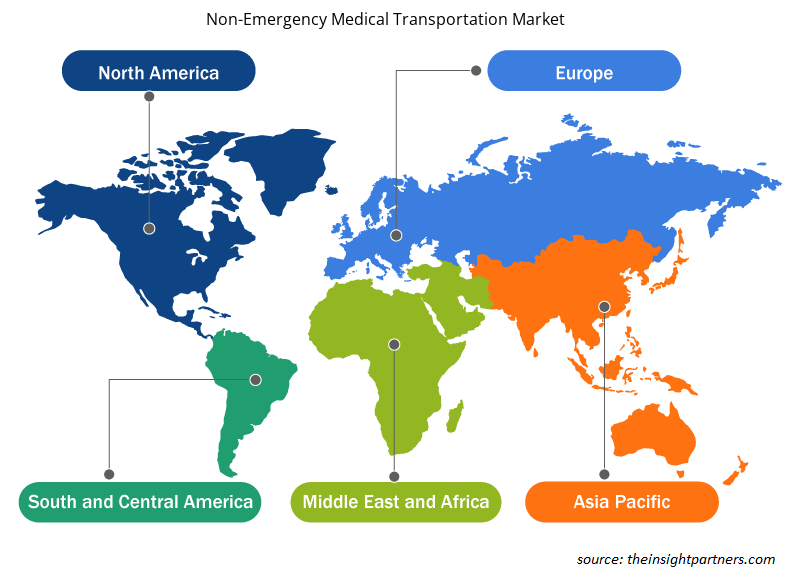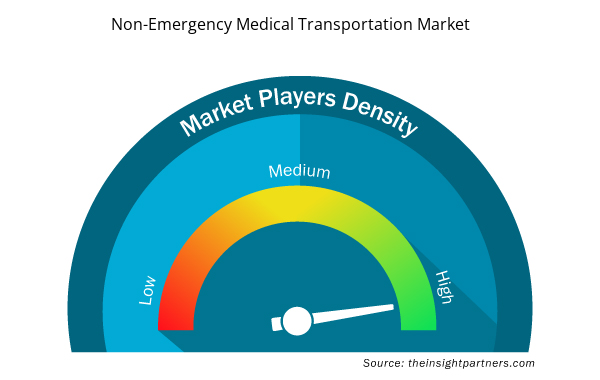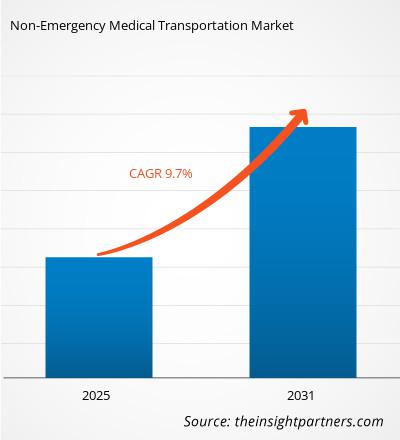非緊急医療輸送市場規模は、2024年の167億1,480万米ドルから2031年には318億7,249万米ドルに達すると予測されています。市場は2025年から2031年にかけて9.7%の年平均成長率(CAGR)を記録すると予想されています。非緊急医療輸送における技術の進歩は、今後数年間で市場に新たなトレンドをもたらす可能性が高いでしょう。
非緊急医療輸送市場分析
非緊急医療輸送市場を牽引する要因としては、非緊急医療輸送の需要増加と、高齢化社会における慢性疾患の急増が挙げられます。さらに、非緊急医療輸送分野における技術開発も市場の成長に寄与すると期待されています。市場関係者による戦略的取り組みは、今後数年間で多くのビジネスチャンスを生み出すことが期待されます。
非緊急医療輸送市場の概要
北米は、非緊急医療輸送市場の大部分を占めると予想されており、アジア太平洋地域は、高齢者の慢性疾患の罹患率の増加と、改善されたヘルスケアソリューションに対する需要の高まりにより、大幅な成長率を記録すると予想されています。医療費の増加と医療インフラの発展、医療ツーリズムの急増も、これらの地域での非緊急医療輸送の需要を高めています。アジア太平洋地域では、中国が大きな市場シェアを占めており、インドはこの地域で大幅な成長率を記録しています。中国は、医療技術の革新をさらに進めるために、今後数年間で1.5兆米ドルを投資する計画です。「健康中国2030」計画に加えて、この支出は、技術の進歩と医療システムの改善を通じて、中国国内の健康の公平性を確保することを目的としています。民政部と中国国家高齢化委員会の報告書によると、中国は世界でも有数の高齢化人口を抱えています。 2023年には、60歳以上の人口は2億9,700万人を超え、総人口の21.1%を占めることになります。中国の高齢者人口は慢性疾患による負担の増加に直面しており、加齢が疾患発症の主なリスク要因となっています。2024年にBMJジャーナルに掲載された研究「中国における慢性疾患の満たされていないニーズ」によると、非感染性疾患( NCD)は中国における最も重大な健康上の脅威であり、全死亡の91%を占めています。中国における主要なNCDには、心血管疾患(43%)、がん(23%)、糖尿病(2%)などがあります。
要件に合わせてレポートをカスタマイズ
このレポートの一部、国レベルの分析、Excelデータパックなど、あらゆるレポートを無料でカスタマイズできます。また、スタートアップや大学向けのお得なオファーや割引もご利用いただけます。
非緊急医療輸送市場:

- このレポートの主要な市場動向を入手してください。この無料サンプルには、市場動向から見積もりや予測に至るまでのデータ分析が含まれます。
非緊急医療輸送市場の推進要因と機会
非緊急医療輸送の需要増加
アメリカ病院協会によると、米国では毎年約360万人が交通問題(車両によるアクセスの不足、医療施設までの距離の遠さ、公共交通機関のインフラの不足、交通費など)により必要な医療を受けられていません。カリフォルニア大学デービス校ヘルスの調査によると、交通障壁により毎年約580万人のアメリカ人が医療を受け損ねたり、遅れたりしていることが明らかになりました。交通手段は、医療予約の取り忘れに大きく影響しています。カイザー・パーマネンテが2019年に実施した調査では、アメリカ人の3分の1が交通手段によるストレスを頻繁に、または時折感じていることが明らかになりました。
1965年以来、メディケイドには非緊急医療搬送(NEMT)給付があり、メディケイド加入者には必須給付として搬送サービスが提供されています。メディケイド登録・解約トラッカーによると、2023年4月までにメディケイドに加入していた人は合計約9,400万人でした。KFFメディケイド予算調査では、主にCOVID-19危機と失業率の上昇により、2021年の米国の医療加入者数は8.2%増加すると予測されています。メディケイドを利用できる人が増えるにつれて、 NEMTサービスの需要も直接的に増加します。
米国のほとんどの州は、 NEMTブローカーまたはマネージドケア組織(MCO )を通じてNEMTを提供する体制に移行しています。多くの州では、ブローカーまたはMCOはNEMTサービスを監督するために一人当たりの支払いを受けていますが、ネバダ州、アリゾナ州、バーモント州など、その他の州では、地域のサービスプロバイダーを通じて出来高払い方式でNEMTを提供しています。児童健康保険プログラム(CHIP)は、メディケイドと別のCHIPプログラムを通じて、対象となる子供に健康保険を提供しています。CHIPは、連邦政府の要件に従って州によって運営され、州政府と連邦政府が共同で資金を提供しています。したがって、政府によるこのような取り組みの増加に伴い、NEMTの需要が高まり、市場の成長を促進しています。
NEMTと交通ネットワーク企業による戦略的取り組みが市場成長の大きな機会を創出
NEMT企業と交通ネットワーク企業(TNC)は、医療へのアクセス向上に向けた戦略的な取り組みに意欲的です。UberやLyftなどのTNCは、オンデマンドの配車サービスとユーザーフレンドリーなモバイルアプリで知られています。これらの機能は、NEMTサービスに関連する可用性とスケジュールの問題に効果的に対処できます。現在、多くのTNCが新しいプラットフォームを開発したり、NEMTや世界中の個々の医療サービス提供者と連携したりしています。いくつかの州政府機関は、TNCによるNEMTサービスの提供を許可しています。以下にいくつかの例を示します。
- Uberは2024年6月、患者の医療予約への到着を支援するプラットフォーム「Uber Health」を正式に導入しました。これにより、予約のキャンセルを減らし、予約時間厳守を向上させることができます。この取り組みはHIPAA(医療保険の携行性と責任に関する法律)に準拠しており、従来のタクシーサービスに代わる費用対効果の高い代替手段を提供します。特に、専用の輸送リソースを持たない小規模な医療機関にとって大きなメリットとなります。米国250以上の都市を網羅するUberのヘルスケアに特化したプラットフォームは、NEMTへのアクセスを大幅に拡大します。
- 2024年1月、CTGパートナー企業であるMediDriveが正式にNEMT市場に参入しました。同社は、患者の医療機関への往診や処置への送迎における複雑な問題解決に取り組んでいます。
- 2022年6月、MTMは積極的な旅行管理を提供するElevateプログラムを開始しました。MTMは、Elevateプログラム会員の旅行管理に積極的なアプローチを採用し、複雑な旅程に対してコンシェルジュレベルのサービスを提供し、会員の個々の移動ニーズに対応しています。
- 2022年2月、Modivcare Inc.はModivcare Academyを設立しました。この革新的な取り組みは、教育リソース、ネットワーキングの機会、そしてトレーニングを提供することで、NEMT(緊急医療ケア)に取り組む輸送事業者を支援することを目的としています。このプログラムは、輸送事業者に不可欠なビジネスツール、ベストプラクティス、そしてトレーニングを提供し、国内で最も脆弱な人々のケアを効果的に支援するための独自のツールを提供します。
こうした戦略的取り組みは、サービス効率の向上、患者アクセスの向上、運用コストの削減、そして医療サービスとのより緊密な連携に重点を置いています。NEMTセクターが成長を続ける中で、これらの取り組みは、世界中でサービスの拡大と患者ケアの質の向上に不可欠となるでしょう。
非緊急医療輸送市場レポートのセグメンテーション分析
非緊急医療輸送市場分析の導出に貢献した主なセグメントは、サービスタイプ、施設、アプリケーション、およびエンドユーザーです。
- サービスの種類に基づいて、非緊急医療輸送市場は、自費患者輸送、保険付き患者輸送、宅配サービス、その他に分類されます。自費患者輸送セグメントは2024年に最大の市場シェアを占め、2024年から2031年にかけて市場で最も高いCAGRを記録すると予想されています。
- 施設別に見ると、非緊急医療搬送市場は施設内輸送と施設間輸送に分かれています。施設間輸送セグメントは2024年に市場シェアを拡大し、2024年から2031年にかけて高いCAGRを記録すると予想されています。
- 用途別に見ると、非緊急医療輸送市場は、透析、定期検診、メンタルヘルス関連の診察、リハビリテーション、その他に分類されます。メンタルヘルス関連の診察セグメントは2024年に最大の市場シェアを占め、リハビリテーションセグメントは2024年から2031年にかけて市場で最も高いCAGRを記録すると予想されています。
- エンドユーザーの観点から見ると、非緊急医療輸送市場は、病院・診療所、介護施設、在宅ケア施設、MCOおよび州政府機関、医療保険者、その他に分類されます。2024年には病院・診療所セグメントが市場を席巻し、2024年から2031年にかけて介護施設セグメントが最も高いCAGRを記録すると予想されています。
非緊急医療輸送市場シェアの地域別分析
非緊急医療輸送市場レポートの地理的範囲は、主に北米、アジア太平洋、ヨーロッパ、中東およびアフリカ、南米および中米の 5 つの地域に分かれています。
2023年には北米が大きな市場シェアを占めました。非緊急医療輸送市場の成長は、様々な疾患の蔓延、非緊急医療輸送(NEMT)に対する保険適用範囲の拡大、そしてこれらのサービスに対する州ごとの管理費または医療費としての償還率の高さに起因しています。さらに、患者中心のケアへの移行、NEMTへの意識の高まり、そして技術の進歩も、市場の成長を支える要因の一つです。慢性疾患、高齢化、障害、怪我、肥満などは、アメリカ人が非緊急医療輸送サービスに頼る多くの理由のほんの一部に過ぎません。パンデミックは、診察、必要な医師の診察、日常的な治療のための信頼できる自動車輸送の需要を増大させました。さらに、高齢者数の増加は、米国の非緊急医療輸送市場の成長に貢献しています。さらに、市場で事業を展開している企業は、市場拡大のために有機的および無機的な開発戦略を採用しています。以下に同様の例をいくつか示します。
- マサチューセッツ州に拠点を置く民間医療輸送会社、Coastal Medical Transportation Systems(CMTS)は、2022年9月にTransformative Healthcareの医療輸送部門を買収しました。この部門には、LifeLine Ambulance ServiceとFallon Ambulance Serviceが含まれていました。この買収により、CMTSは、サービス提供患者数とサービス提供エリアの両面で、州内最大規模の救急車ネットワークの一つとなりました。
- 2022年9月、ベイステート・ウィング病院はマサチューセッツ州の医療従事者向けに交通サービスを提供するため、クアボアグ・コネクターと提携しました。このカーブ・ツー・カーブサービスはNEMT(ニュートラル・メディカル・メンテナンス)に対応しており、患者はベイステート・ウィング病院の施設への送迎をリクエストできます。
非緊急医療輸送市場の地域別分析
予測期間全体を通して非緊急医療輸送市場に影響を与える地域的な傾向と要因は、Insight Partnersのアナリストによって徹底的に説明されています。このセクションでは、北米、ヨーロッパ、アジア太平洋、中東・アフリカ、中南米における非緊急医療輸送市場のセグメントと地域についても説明します。

- 非緊急医療輸送市場の地域別データを入手
非緊急医療輸送市場レポートの範囲
| レポート属性 | 詳細 |
|---|---|
| 2024年の市場規模 | 167億1,480万米ドル |
| 2031年までの市場規模 | 318億7,249万米ドル |
| 世界のCAGR(2025年~2031年) | 9.7% |
| 履歴データ | 2021-2023 |
| 予測期間 | 2025~2031年 |
| 対象セグメント | サービスタイプ別
|
| 対象地域と国 | 北米
|
| 市場リーダーと主要企業の概要 |
|
非緊急医療輸送市場のプレーヤー密度:ビジネスダイナミクスへの影響を理解する
非緊急医療輸送市場は、消費者の嗜好の変化、技術の進歩、製品の利点に対する認知度の高まりといった要因によるエンドユーザーの需要増加に牽引され、急速に成長しています。需要の増加に伴い、企業は提供内容を拡大し、消費者ニーズを満たすための革新を進め、新たなトレンドを活用しており、これが市場の成長をさらに加速させています。
市場プレーヤー密度とは、特定の市場または業界内で事業を展開する企業または会社の分布を指します。これは、特定の市場空間における競合企業(市場プレーヤー)の数が、その市場規模または市場価値全体と比較してどれだけ多いかを示します。
非緊急医療輸送市場で事業を展開している主要企業は次のとおりです。
- 株式会社MTM
- AMR
- エクスプレス輸送
- CJ医療輸送
- ヴェリダ
免責事項:上記の企業は、特定の順序でランク付けされているわけではありません。

- 非緊急医療輸送市場のトップキープレーヤーの概要を入手
非緊急医療輸送市場のニュースと最近の動向
非緊急医療輸送市場は、主要な企業出版物、協会データ、データベースなどを含む一次調査および二次調査を経て、定性・定量データを収集することで評価されます。非緊急医療輸送市場における動向のいくつかを以下に示します。
- Modivcare Inc.は、NEMT給付を受けるメディケイドおよびメディケア加入者のエンゲージメントとエクスペリエンスを革新する画期的なデジタルプラットフォーム「Integration Hub」を発表しました。ModivcareのIntegration Hubは、業界初の拡張可能なモジュール型モビリティプラットフォームであり、オープンなアプリケーション・プログラミング・インターフェース(API)を民間医療保険の顧客、州のメディケイド機関、そして施設パートナーに提供します。(出典:ModivCare、企業ウェブサイト、2024年5月)
- 全米最大の非上場NEMTブローカーであるMTMは、Global Medical ResponseとAccess2Care, LLCの買収契約を締結しました。この戦略的買収により、MTMの市場プレゼンスは大幅に強化され、年間総収益は増加し、同社の成長軌道における重要な節目となりました。Access2CareのNEMT事業の買収は、慎重な検討の結果であり、MTMの戦略的拡大計画と合致しています。(出典:MTM, Inc.、企業ウェブサイト、2024年8月)
- アケイディアン・アンビュランス・サービスは、テキサス州ニューブラウンフェルズに拠点を置く救急医療サービスプロバイダーであるサザンクロス・アンビュランスの資産を実質的に全て買収する契約を締結したことを発表しました。この買収により、アケイディアンは救急車12台と車椅子バン10台を追加で運用し、新規従業員も雇用できるようになります。サザンクロス・アンビュランスは、南中部および南テキサス地域において、緊急時および非緊急時の救急車搬送サービスを提供しており、病院、リハビリテーションセンター、クリニック、介護施設、熟練看護センターへの地域および長距離の救急車搬送サービスを提供しています。(出典:アケイディアン・アンビュランス・サービス、企業ウェブサイト、2024年1月)
非緊急医療輸送市場レポートの対象範囲と成果物
「非緊急医療輸送市場の規模と予測(2021〜2031年)」レポートでは、以下の分野をカバーする市場の詳細な分析を提供しています。
- 調査対象範囲に含まれるすべての主要市場セグメントについて、世界、地域、国レベルでの非緊急医療輸送市場の規模と予測
- 非緊急医療輸送市場の動向、および推進要因、制約、主要な機会などの市場動向
- 詳細なPEST分析とSWOT分析
- 主要な市場動向、世界および地域の枠組み、主要プレーヤー、規制、最近の市場動向を網羅した非緊急医療輸送市場分析
- 非緊急医療輸送市場における市場集中、ヒートマップ分析、主要プレーヤー、最近の動向を網羅した業界の展望と競争分析
- 詳細な企業プロフィール
- 過去2年間の分析、基準年、CAGRによる予測(7年間)
- PEST分析とSWOT分析
- 市場規模価値/数量 - 世界、地域、国
- 業界と競争環境
- Excel データセット


- Nurse Call Systems Market
- Artificial Intelligence in Defense Market
- Blood Collection Devices Market
- Hydrocephalus Shunts Market
- Investor ESG Software Market
- Sweet Potato Market
- Medical Enzyme Technology Market
- Pressure Vessel Composite Materials Market
- Enteral Nutrition Market
- Semiconductor Metrology and Inspection Market

Report Coverage
Revenue forecast, Company Analysis, Industry landscape, Growth factors, and Trends

Segment Covered
This text is related
to segments covered.

Regional Scope
North America, Europe, Asia Pacific, Middle East & Africa, South & Central America

Country Scope
This text is related
to country scope.
よくある質問
The global non-emergency medical transportation market is estimated to register a CAGR of 9.7% during the forecast period.
The estimated value of the non-emergency medical transportation market can reach US$ 31,872.49 million by 2031.
North America dominated the non-emergency medical transportation market in 2024.
The increasing increasing need for non-emergency medical transportation and surging incidence of chronic conditions among aging populations. arethe most influential factors responsible for the market growth.
MTM, Inc.; AMR; Xpress Transportation; CJ Medical Transportation; VERIDA; ModivCare; Crothall Healthcare; Elite Medical Transport; Acadian Ambulance Service; Transdev; Ride Health; Roundtrip; Medical Answering Services, LLC; One Call; Stellar Transport; Abba Medical Transportation, LLC; Able Medical Transportation, Inc.; Life Ride; Mobility Transportation Services, Inc.; and ABC Non-Emergency Medical Transportation, LLC are among the key players operating in the non-emergency medical transportation market.
Trends and growth analysis reports related to Life Sciences : READ MORE..
The List of Companies - Non-Emergency Medical Transportation Market
- MTM, Inc.
- AMR
- Xpress Transportation
- CJ Medical Transportation
- VERIDA
- ModivCare
- Crothall Healthcare
- Elite Medical Transport
- Acadian Ambulance Service
- Transdev
- Ride Health
- Roundtrip
- Medical Answering Services, LLC
- One Call
- Stellar Transport
- Abba Medical Transportation, LLC
- Able Medical Transportation, Inc.
- Life Ride
- Mobility Transportation Services, Inc.
- ABC Non-Emergency Medical Transportation, LLC
The Insight Partners performs research in 4 major stages: Data Collection & Secondary Research, Primary Research, Data Analysis and Data Triangulation & Final Review.
- Data Collection and Secondary Research:
As a market research and consulting firm operating from a decade, we have published and advised several client across the globe. First step for any study will start with an assessment of currently available data and insights from existing reports. Further, historical and current market information is collected from Investor Presentations, Annual Reports, SEC Filings, etc., and other information related to company’s performance and market positioning are gathered from Paid Databases (Factiva, Hoovers, and Reuters) and various other publications available in public domain.
Several associations trade associates, technical forums, institutes, societies and organization are accessed to gain technical as well as market related insights through their publications such as research papers, blogs and press releases related to the studies are referred to get cues about the market. Further, white papers, journals, magazines, and other news articles published in last 3 years are scrutinized and analyzed to understand the current market trends.
- Primary Research:
The primarily interview analysis comprise of data obtained from industry participants interview and answers to survey questions gathered by in-house primary team.
For primary research, interviews are conducted with industry experts/CEOs/Marketing Managers/VPs/Subject Matter Experts from both demand and supply side to get a 360-degree view of the market. The primary team conducts several interviews based on the complexity of the markets to understand the various market trends and dynamics which makes research more credible and precise.
A typical research interview fulfils the following functions:
- Provides first-hand information on the market size, market trends, growth trends, competitive landscape, and outlook
- Validates and strengthens in-house secondary research findings
- Develops the analysis team’s expertise and market understanding
Primary research involves email interactions and telephone interviews for each market, category, segment, and sub-segment across geographies. The participants who typically take part in such a process include, but are not limited to:
- Industry participants: VPs, business development managers, market intelligence managers and national sales managers
- Outside experts: Valuation experts, research analysts and key opinion leaders specializing in the electronics and semiconductor industry.
Below is the breakup of our primary respondents by company, designation, and region:

Once we receive the confirmation from primary research sources or primary respondents, we finalize the base year market estimation and forecast the data as per the macroeconomic and microeconomic factors assessed during data collection.
- Data Analysis:
Once data is validated through both secondary as well as primary respondents, we finalize the market estimations by hypothesis formulation and factor analysis at regional and country level.
- Macro-Economic Factor Analysis:
We analyse macroeconomic indicators such the gross domestic product (GDP), increase in the demand for goods and services across industries, technological advancement, regional economic growth, governmental policies, the influence of COVID-19, PEST analysis, and other aspects. This analysis aids in setting benchmarks for various nations/regions and approximating market splits. Additionally, the general trend of the aforementioned components aid in determining the market's development possibilities.
- Country Level Data:
Various factors that are especially aligned to the country are taken into account to determine the market size for a certain area and country, including the presence of vendors, such as headquarters and offices, the country's GDP, demand patterns, and industry growth. To comprehend the market dynamics for the nation, a number of growth variables, inhibitors, application areas, and current market trends are researched. The aforementioned elements aid in determining the country's overall market's growth potential.
- Company Profile:
The “Table of Contents” is formulated by listing and analyzing more than 25 - 30 companies operating in the market ecosystem across geographies. However, we profile only 10 companies as a standard practice in our syndicate reports. These 10 companies comprise leading, emerging, and regional players. Nonetheless, our analysis is not restricted to the 10 listed companies, we also analyze other companies present in the market to develop a holistic view and understand the prevailing trends. The “Company Profiles” section in the report covers key facts, business description, products & services, financial information, SWOT analysis, and key developments. The financial information presented is extracted from the annual reports and official documents of the publicly listed companies. Upon collecting the information for the sections of respective companies, we verify them via various primary sources and then compile the data in respective company profiles. The company level information helps us in deriving the base number as well as in forecasting the market size.
- Developing Base Number:
Aggregation of sales statistics (2020-2022) and macro-economic factor, and other secondary and primary research insights are utilized to arrive at base number and related market shares for 2022. The data gaps are identified in this step and relevant market data is analyzed, collected from paid primary interviews or databases. On finalizing the base year market size, forecasts are developed on the basis of macro-economic, industry and market growth factors and company level analysis.
- Data Triangulation and Final Review:
The market findings and base year market size calculations are validated from supply as well as demand side. Demand side validations are based on macro-economic factor analysis and benchmarks for respective regions and countries. In case of supply side validations, revenues of major companies are estimated (in case not available) based on industry benchmark, approximate number of employees, product portfolio, and primary interviews revenues are gathered. Further revenue from target product/service segment is assessed to avoid overshooting of market statistics. In case of heavy deviations between supply and demand side values, all thes steps are repeated to achieve synchronization.
We follow an iterative model, wherein we share our research findings with Subject Matter Experts (SME’s) and Key Opinion Leaders (KOLs) until consensus view of the market is not formulated – this model negates any drastic deviation in the opinions of experts. Only validated and universally acceptable research findings are quoted in our reports.
We have important check points that we use to validate our research findings – which we call – data triangulation, where we validate the information, we generate from secondary sources with primary interviews and then we re-validate with our internal data bases and Subject matter experts. This comprehensive model enables us to deliver high quality, reliable data in shortest possible time.

 このレポートの無料サンプルを入手する
このレポートの無料サンプルを入手する